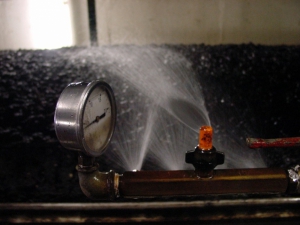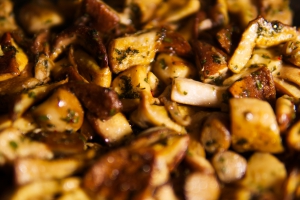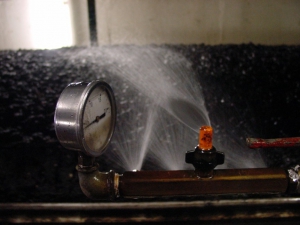Water, the ongoing discussion
If one wants to start a discussion with a grower (or with a consultant), start talking about watering.
How much, when and what watering method.
To make any sense though, you first have to define the period. There is watering on casing soil and watering over mushrooms and between flushes.
This blog is about watering on the casing soil during the incubation period. The water given in that period is to bring the casing soil up to the maximum moisture level and to keep the compost at the right moisture.
A good phase 3 compost at the moment of casing will be around 60% in moisture. For white strains that can be up to 3% higher, brown strains prefer 1 or 2% drier. It is not possible to bring the compost to a much higher moisture level by watering it after filling. It is possible to give water into the compost but that will be free water which has to disappear during the fructification period.
2 up to 4 litres of water can be given into the compost at filling or later but that should be the maximum. Even if it is necessary to cool the compost. This can better be done by giving water into the casing and let it evaporate with fresh air and circulation.
Casing soil itself can handle up to 7 litres per m² plus the water that was originally in the casing. To be sure, we talk about a casing containing white and black peat.
More than 7 litres will evaporate, go into the compost or down the drain.
Considering that the evaporation can be around 2 litres per m² per day, the loss with evaporation is about 10 litres. If you count the loss of dripping, the water staying in the compost and the evaporation you come to a figure of about 25 litres of water. In practical situations this means a total amount of water between 20 and 30 litres average. Depending on the farm and the time of the year. Growing drier often means a loss of production and growing a lot wetter means problems in growing, mainly in the outgrow of mushrooms.
Another thing to watch for is the watering method. Make sure that the pressure of the water onto the casing is not too high. Too many times I see a casing with a damaged surface which will give problems in the evaporation.
Every system has a different pressure and if you are not sure, ask the manufacturer. Regularly cleaning of the nozzles is something will help maintaining the right pressure and the right adjustment of the watering trees, looking at distance and height according to the casing level.
Keep watering but do not take it over the top!!
Pitfalls preparing mushrooms
There are plenty of ways to prepare or use mushrooms in a delicious meal. But one of the tastiest ways is to brown the mushrooms. But how do you get them so nice and golden brown? With these 5 tips, what you should definitely not do, it will certainly work the next time!
Do not wash
You should never clean mushrooms with water. This is because they are porous and absorb moisture like a sponge. This will make them mushy and lose their flavor. So clean the mushrooms with a brush or with a piece of kitchen paper.
Not too much butter or oil
If you are going to fry mushrooms, let the pan get very hot. This way the least amount of water will run out of the mushrooms and they will not become dry. Also do not use too much butter or oil because they will absorb it completely and then you will not get nicely browned mushrooms.
Not too much in the pan
Do not fry all the mushrooms at once, but give the mushrooms enough space in the pan. This way the moisture released from the mushrooms has plenty of room to evaporate and you prevent the mushrooms from stewing instead of frying.
Do not add salt too quickly
Salt draws moisture from the mushrooms. So let them fry until golden brown before adding salt. It is also better to wait until the end with adding other spices such as pepper or parsley.
Do not stir
Resist the urge to stir your pan all the time. The mushrooms need enough time to caramelize. Because then do they get that golden brown edge? Only then is it time to start stirring so that the other side can brown nicely.
Good luck and enjoy your mushrooms!
Water, the ongoing discussion
If one wants to start a discussion with a grower (or with a consultant), start talking about watering.
How much, when and what watering method.
To make any sense though, you first have to define the period. There is watering on casing soil and watering over mushrooms and between flushes.
This blog is about watering on the casing soil during the incubation period. The water given in that period is to bring the casing soil up to the maximum moisture level and to keep the compost at the right moisture.
A good phase 3 compost at the moment of casing will be around 60% in moisture. For white strains that can be up to 3% higher, brown strains prefer 1 or 2% drier. It is not possible to bring the compost to a much higher moisture level by watering it after filling. It is possible to give water into the compost but that will be free water which has to disappear during the fructification period.
2 up to 4 litres of water can be given into the compost at filling or later but that should be the maximum. Even if it is necessary to cool the compost. This can better be done by giving water into the casing and let it evaporate with fresh air and circulation.
Casing soil itself can handle up to 7 litres per m² plus the water that was originally in the casing. To be sure, we talk about a casing containing white and black peat.
More than 7 litres will evaporate, go into the compost or down the drain.
Considering that the evaporation can be around 2 litres per m² per day, the loss with evaporation is about 10 litres. If you count the loss of dripping, the water staying in the compost and the evaporation you come to a figure of about 25 litres of water. In practical situations this means a total amount of water between 20 and 30 litres average. Depending on the farm and the time of the year. Growing drier often means a loss of production and growing a lot wetter means problems in growing, mainly in the outgrow of mushrooms.
Another thing to watch for is the watering method. Make sure that the pressure of the water onto the casing is not too high. Too many times I see a casing with a damaged surface which will give problems in the evaporation.
Every system has a different pressure and if you are not sure, ask the manufacturer. Regularly cleaning of the nozzles is something will help maintaining the right pressure and the right adjustment of the watering trees, looking at distance and height according to the casing level.
Keep watering but do not take it over the top!!
























